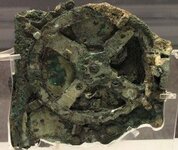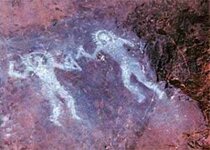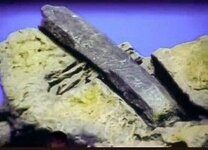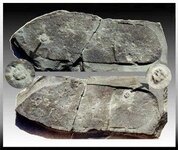DeepseekerADS
Gold Member
- Mar 3, 2013
- 14,880
- 21,733
- Detector(s) used
- CTX, Excal II, EQ800, Fisher 1260X, Tesoro Royal Sabre, Tejon, Garrett ADSIII, Carrot, Stealth 920iX, Keene A52
- Primary Interest:
- Other
5 Reasons According to Science, Darwin's Theory of Evolution Is Totally Wrong
Beyond Science, Lists, News
November 19, 2014
by Tatiana Tobar-Darzi R. | Epoch Times
In school we learned that dinosaurs became extinct about 65 million years ago, and small mammals survived and evolved into other mammals and at some point around 250,000 years ago an apelike mammal evolved into what is now the modern human—right?
Newly discovered artifacts raise the question, has humanity been around much longer than we originally thought? And, did those ancient humans actually live a primitive life, as is generally assumed?
Maybe it’s time to update our ancient history and science textbooks.
Here are some prehistoric findings that baffle scientists about our human history:
1. The Antikythera Mechanism—Made over 2,000 years ago

The Antikythera Mechanism is a 2000-year-old mechanical device used to calculate the positions of the sun, moon, planets, and even the dates of the ancient Olympic Games. (Wikimedia Commons)
Originally discovered in 1901, it wasn’t until modern scanning tools in the 21st century that the intricate interlocking gears were discovered. Made by the Greeks—this ancient computer can accurately calculate astronomical changes.
2. Mineral Paint in Caves—Painted 15,000 to 50,000 years ago

Cave paintings as old as 10,000 years in Valcamonica, Italy, show people wearing what some have said are space suits. (Wikimedia Commons)
Inside different caves from around the world there are prehistoric paintings of society with graphic details of an unexpected nature—such as people wearing shirts, pants, boots, and hats.
3. The London Hammer—110-115 million years old and encased within a multimillion-year-old rock

Replica of the London Hammer as presented in a slide by Dr. Doug Newton of the non-profit organization Trinity Creation Studies. (Screenshot/YouTube)
Found in London, Texas, in 1936 by 2 hikers—the hammer (of unknown use) is not just 110 to 115 million years old, but also it was found apparently encased within a multi-million-year-old rock.
4. Shoeprint on Trilobite Fossil—Shoeprint was made 200-600 million years ago

A fossilized footprint stepping on a trilobite, an extinct marine arthropod. Trilobites are known to have gone extinct around 260 million years ago.
In June 1968, a fossilized footprint with a trilobite fossil embedded in it proves nearly impossible since trilobites went extinct around 280 million years ago. The fossilized footprint—wearing size 13 shoes—is estimated to be between 200 and 600 million years old.
5. Nuclear Reactor in the Gabon Republic of Africa—1.8 billion years old

Gabon Republic/Shutterstock
In 1972, a French factory imported uranium ore from Oklo, Gabon, and found that a key uranium isotope had been depleted, as if a nuclear reaction had already taken place. Scientists from around the world went to study this phenomenon and discovered an underground nuclear reactor. Some assume that it was a “natural” reactor, while others point out that this would have been very unlikely. It has since been completely destroyed by mining, leaving a mystery.
Beyond Science, Lists, News
November 19, 2014
by Tatiana Tobar-Darzi R. | Epoch Times
In school we learned that dinosaurs became extinct about 65 million years ago, and small mammals survived and evolved into other mammals and at some point around 250,000 years ago an apelike mammal evolved into what is now the modern human—right?
Newly discovered artifacts raise the question, has humanity been around much longer than we originally thought? And, did those ancient humans actually live a primitive life, as is generally assumed?
Maybe it’s time to update our ancient history and science textbooks.
Here are some prehistoric findings that baffle scientists about our human history:
1. The Antikythera Mechanism—Made over 2,000 years ago

The Antikythera Mechanism is a 2000-year-old mechanical device used to calculate the positions of the sun, moon, planets, and even the dates of the ancient Olympic Games. (Wikimedia Commons)
Originally discovered in 1901, it wasn’t until modern scanning tools in the 21st century that the intricate interlocking gears were discovered. Made by the Greeks—this ancient computer can accurately calculate astronomical changes.
2. Mineral Paint in Caves—Painted 15,000 to 50,000 years ago

Cave paintings as old as 10,000 years in Valcamonica, Italy, show people wearing what some have said are space suits. (Wikimedia Commons)
Inside different caves from around the world there are prehistoric paintings of society with graphic details of an unexpected nature—such as people wearing shirts, pants, boots, and hats.
3. The London Hammer—110-115 million years old and encased within a multimillion-year-old rock

Replica of the London Hammer as presented in a slide by Dr. Doug Newton of the non-profit organization Trinity Creation Studies. (Screenshot/YouTube)
Found in London, Texas, in 1936 by 2 hikers—the hammer (of unknown use) is not just 110 to 115 million years old, but also it was found apparently encased within a multi-million-year-old rock.
4. Shoeprint on Trilobite Fossil—Shoeprint was made 200-600 million years ago

A fossilized footprint stepping on a trilobite, an extinct marine arthropod. Trilobites are known to have gone extinct around 260 million years ago.
In June 1968, a fossilized footprint with a trilobite fossil embedded in it proves nearly impossible since trilobites went extinct around 280 million years ago. The fossilized footprint—wearing size 13 shoes—is estimated to be between 200 and 600 million years old.
5. Nuclear Reactor in the Gabon Republic of Africa—1.8 billion years old

Gabon Republic/Shutterstock
In 1972, a French factory imported uranium ore from Oklo, Gabon, and found that a key uranium isotope had been depleted, as if a nuclear reaction had already taken place. Scientists from around the world went to study this phenomenon and discovered an underground nuclear reactor. Some assume that it was a “natural” reactor, while others point out that this would have been very unlikely. It has since been completely destroyed by mining, leaving a mystery.



